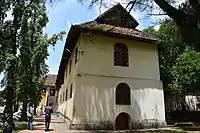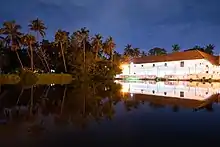Mattancherry Palace
The Mattancherry Palace is a Portuguese palace popularly known as the Dutch Palace, in Mattancherry, Kochi, in the Indian state of Kerala which features Kerala murals depicting portraits and exhibits of the Rajas of Kochi. The palace was included in the "tentative list" of UNESCO World Heritage Site.[2]
| Mattancherry Palace | |
|---|---|
 | |
| Location | Kochi, Kerala, India |
| Coordinates | 9.958°N 76.259°E |
| Built | 1545[1] |
 Location in Kerala, India | |

History
The Palace was built and gifted by the Portuguese as a present to the king of Cochin around 1545.[1] The Dutch carried out some extensions and renovations in the palace in 1663, and thereafter it was popularly called Dutch Palace. The rajas also made more improvements to it. Today, it is a portrait gallery of the Cochin Rajas and notable for some of the best mythological murals in India, which are in the best traditions of Hindu temple art. The palace was built to appease the king after they plundered a temple nearby.[3][4] The landing of Vasco da Gama, the Portuguese explorer at Kappad in 1498 was welcomed by the Kochi rulers. They were given exclusive right to construct factories. The Portuguese repulsed the repeated attacks of the Zamorians and the Cochin Rajas practically became vassals of the Portuguese. The influence of the Portuguese were supplanted by the Dutch and they took over Mattancherry in 1663.[3] Subsequently, the area was taken over by Hyder Ali and still later by the British East India Company
The Palace
The palace is a quadrangular structure built in Nālukettu style, the traditional Kerala style of architecture, with a courtyard in the middle. In the courtyard there stands a small temple dedicated to 'Pazhayannur Bhagavati', the protective goddess of the Kochi royal family. There are two more temples on either side of the Palace, one dedicated to Lord Krishna and the other to Lord Siva. Certain elements of architecture, as for example the nature of its arches and the proportion of its chambers are indicative of European influence in basic Nālukettu style.[3][4]
The Dining Hall has carved wooden ornate ceiling decorated with a series of brass cups. The palace also contains rare examples of traditional Kerala flooring, which looks like polished black marble but is actually a mixture of burned coconut shells, charcoal, lime, plant juices, and egg whites.[4]
Murals

The glory of the palace rests on the large number of murals, executed in the best traditions of Hindu temple art, which are religious, decorative and stylised. The murals have been painted in rich warm colours in tempera technique.[3]
The king's bedchamber or Palliyara, to the left of the entrance and occupying the southwest corner of the Palace, is noteworthy with its low wooden ceiling and 300 sq ft (28 m2) of wall surface covered with about 48 paintings. These illustrate the Ramayana, from the beginning of the sacrifice of Dasaratha to Sita's return from captivity in Lanka. The paintings in this section are the earliest in the palace, dating back to the 16th century. The last five scenes are from the 'Krishna Lila', representing a cheerful Lord Krishna with eight of his milkmaid consorts.[4] The paintings are attributed to the artistic bent of mind of Veera Kerala Verma.[3]
The upper staircase rooms, notably that of the coronation hall that was extended under Dutch patronage, contain some murals. The notable compositions in this section are - Lakshmi seated on the lotus, sleeping Vishnu (Ananthasayanamurti), Shiva and Parvati seated with Ardhanariswara and other goddesses, the coronation of Rama, and Krishna lifting Mount Govardhana.[4]
On the opposite side of the coronation hall is the staircase room or Kovinithalam (Room No II), with a descent to the lower storey, there are four paintings of Shiva, Vishnu and Devi, and one incomplete. Room No. IV depict scenes from Kumarasambhava and other works of the great Sanskrit poet Kālidāsa.[4] The latter set of paintings belonging to the eighteenth century.[3]
Other exhibits
Portraits of the Rajas of Cochin, from 1864 onwards, are displayed in what was once the Coronation Hall. These were painted by local artists in western style. The ceiling of the hall is decorated with floral designs in woodcraft.
Amongst the other exhibits in the palace are an ivory palanquin, a howdah, royal umbrellas, ceremonial dress used by the royalty, coins, stamps and drawings. .[3]
Restoration
In 1951, Mattancherry Palace was restored and declared a centrally protected monument. The palace is already undergoing a second restoration by the Archaeological Survey of India. The restoration will raise the historical structure to a building and a museum of an international standard, preserving its originality, yet highlighting the important facets, The palace is an architectural masterpiece showcasing the blend between colonial and Kerala architecture. The restoration aims at showcasing its true grandeur. The work which started in 2007 was scheduled to be completed by 2009.[5]
Paradesi Synagogue

Nearby is the Paradesi Synagogue built in 1568. Alongside are the antique shops in the meandering alleys of Jew Town, most of whose inhabitants have since migrated to Israel. The Mattancherry jetty and bus stand are behind the Palace. The area is full of shops attracting tourists hunting for mementoes to carry back home.
Situated in between the Mattancherry Palace and the Paradesi Synagogue is the Pazhayannur Bhagavathy Temple, the ancestral deity or Paradevata of the Cochin Royal Family. The temple with royal patronage which shares its wall with the Jewish synagogue tells volumes about the religious tolerance and intercultural amity that existed during the time of the Kingdom of Cochin.[6]
References
- "Heritage Sites in Kochi". Incredible India. Ministry of Tourism (India). Retrieved 19 May 2020.
- "Mattanchery Palace, Ernakulam, Kerala". whc.unesco.org.
- Archaeological Museum, Cochin, published by Archaeological Survey of India
- "Mattancherry Palace". webindia.123. Archived from the original on 2 January 2008. Retrieved 20 January 2008.
- Abraham, Tanya. "Back to the Dutch Palace again". Metro Plus Kochi. The Hindu, 17 September 2007. Retrieved 20 January 2008.
- Ayub, Akber (ed), Kerala: Maps & More, Fort Kochi & Mattancherry, 2006 edition 2007 reprint, pp. 24-25, Stark World Publishing, Bangalore, ISBN 81-902505-2-3
External links
| Wikimedia Commons has media related to Mattancherry Palace. |